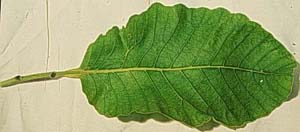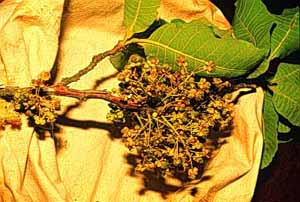
Curatella americana L.
Raspa guacal
(Dilleniaceae)
 |
Curatella americana L. Raspa guacal (Dilleniaceae) | |
Masis, A., Espinoza, R., Perez, D., Guadamuz, A. and Chavarría, F. 1998. Curatella americana (Dilleniaceae) Species Page. 20 January 1998. Species Home Pages, Area de Conservación Guanacaste, Costa Rica. http://www.acguanacaste.ac.cr
I. Identification:
Shrub up to 3-4 (5) tall.
Flower:
Inflorescence an axillary panicle. Petals 4, white, reflexed (hanging down). Stamens many. Pistils 2, light green. Sepals 4, light green.
|
Panicle |
Individual flower, lateral |
|
Flower buds | |
Flowers at the beginning of the dry season. Flowers have a sweet smell. Bees can be observed visiting the flowers and are assumed to be pollinators
Fruits:
The inmature fruits are green and pubescent.
|
Inmature fruits |
Cross section |
Usually the fruits are bi-lobed and have 4 dehiscent valves, 4.8- mm in length; 1 (2) seeds per carpel (González 1997).
|
Mature open fruit |
Open mature fruit showing the aril |
 | |
Inflorescnece | |
Leaves:
The upper surface is dark green, under surface light green. Rough to the touch on both sides. Simple alternate leafs, ovate, undulate margin. About 20-26 cm long.
|
Upper surface |
Young leaf |
|
Close up of the upper surface |
Close up of the under surface |
|
Leaf arrangement |
The petiole is about 3-4 cm long.
Bark and wood:
The bark is light brown and scaly. Wood is cream color.
|
Bark |
Trunk cross section |
Whole plant architecture:
|
Habit |
Similar species:
Tetracera, Doliocarpus and Davilla kunthii (Dilleniaceae) are woody lianas which leaves might look like those of Curatella americana.
Verification:
II.Gepgraphic distribution:
International:
In Costa Rica
In the Area de Conservación Guanacaste:
Curatella americana and Byrsonima crassifolia are the two most common shrubs and trees in the open savannas and highly altered semideciduous and deciduous lowland habitats.
Mapa de macro-habitats del ACG
|
III. Natural history:
It is a fire resistant species. Since it is exposed to fires, its common to find twisted and highly branched individuals.
IV. How to find:
It is very common along the Interamerican highyway and in old pastures and savannas in various degrees of regeneration.
Acknowledgments:
This project was carried out by the Area de Conservación Guanacaste/CR, with help from INBio/CR, ICBG from the Foggarty center, NIH/USA and NSF/USA.
Literature cited:
González. J. 1997. Dilleniaceae. Manual de Flora de Costa Rica. En preparación.